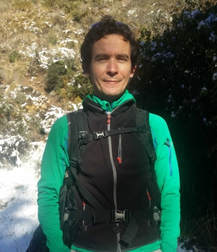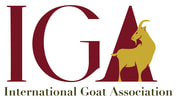|
IGA is proud to announce that Francisco de Asís Ruiz is our new Regional Director for Western Europe. Below is a translation of an interview by OVIESPAÑA with Francisco. Special thanks to OVIESPAÑA for allowing us to use this information. To read the original Spanish version, click here. Francisco de Asís Ruiz is one of the most reputable researchers in the goat sector in Spain. He works as a technician in the Economics Department of the Agrifood Chain of the Andalusian Institute for Agricultural Research and Training (Ifapa) in Granada and has recently been appointed Regional Director of the International Goat Association (IGA) for Western Europe. In this interview, Ruiz analyzes the role played by the IGA, the structure of the European goat sector and its future.  OVIESPAÑA. You have recently been elected as the representative of the International Goat Association (IGA) in western Europe. How is this association organized in Europe? FRANCISCO DE ASÍS RUIZ. Each country has a number of members who elect the Board of Directors (IGA board) every four years, and the board each year evaluates the proposals and elects the representatives of each country. In the case of Spain, in 2014 a proposal was made from the Spanish goat sector at the V National Goat Forum held in Seville and it was decided to propose me as the Country Representative from Spain. Based on the Country Representatives’ activities during the previous four years, the corresponding IGA Committee chooses a Director in each region, and in this case, I was recently elected as Regional Director for Western Europe. OVIESPAÑA. Who are its members? How many researchers do you have? FRANCISCO DE ASÍS RUIZ. The members of the IGA have different profiles: researchers, technicians, extension agents and livestock producers, but there are also other types of members that are the institutional ones, as is the case here in Spain for the Spanish Federation of Associations of Selected Livestock (Feagas). With respect to the number of researchers, it oscillates every year between 200-300, out of 60-80 countries of the world. OVIESPAÑA. Is it the only structure that brings together European goat researchers or are there other groups? How is the relationship with them? FRANCISCO DE ASÍS RUIZ. It is the only existing association of a global nature in the goat sector and, therefore, also for researchers. Another aspect is the individual projects that any researcher can request from the institution where he works, so for example the project ‘Capara’ at the time brought together the principal goat parasitologists from Europe. In these cases, the IGA can act as a collaborating entity or as an institutional support to the project. Regarding the relationship between IGA members, it is intended to be a relationship of horizontal exchange, as involved as possible to allow progress in all facets related to the goat. OVIESPAÑA. What structure does IGA have in Europe? How is your relationship with IGA worldwide? Is it integrated into other research structures? FRANCISCO DE ASÍS RUIZ. IGA is not a research structure per se, although research plays a most important role within the association as the number of its members as researchers is important. In Europe at the moment 15 countries are represented, although there are talks to expand this number, especially in Eastern Europe. The researchers at any given time can be included in the different IGA committees or projects, as was the case for the IFAD project completed in 2016, in which IGA members from different countries participated. In any case, the researchers meet once every four years within the framework of the International Conference on Goats (ICG) organized by the IGA. The next International Conference on Goats will be held in Hungary in the year 2020. OVIESPAÑA. What are the most important objectives that IGA has in Europe? In the short term, are there urgent issues? FRANCISCO DE ASÍS RUIZ. Right now, the main objective to be solved in the short term, is to restructure the relationship between the different European countries, which lately was uncoordinated. And the second objective is to collaborate in certain actions of the IGA, such as the creation of a worldwide Goat Breed Directory. OVIESPAÑA. Which are the most important projects in which IGA is embarked in Europe to advance in its structure? And as far as the research work is concerned? FRANCISCO DE ASÍS RUIZ. At the moment, I am contacting the representatives of the different countries to create a permanent exchange network with the Regional Director. In the same vein, one of the Country Representatives’ responsibilities is to create a network with the representatives of the goat sector of their respective country. The idea is to have a continuous information exchange concerning what happens in the goat sectors of the different European countries, a source of information that practically does not exist today. As far as research is concerned, the IGA does not directly carry out research, but it can be a way to connect researchers from various countries and, for example, request supranational projects. OVIESPAÑA. How is the European goat sector oriented currently? Which are the most important countries and their respective productive orientations? Is there a country that has emerged strongly in recent years? FRANCISCO DE ASÍS RUIZ. In the first place, our European goat sector is currently specialized in the production of milk. Meat, in spite of its nutritional qualities and the fact it was very much consumed and appreciated by the consumers several decades ago, has been replaced by other meats, consumed exclusively on certain calendar dates such as Christmas or Easter. There are goat breeds specialized in meat production, many of them in danger of extinction, therefore we need to devote attention them in the coming years. In the case of milk, it would be necessary to differentiate between three strata: livestock, industry and products. For livestock, the framework is repeated in all European countries, farms with a strong family character, where the farms are managed by members of the same family, who sell their milk to the dairy industry. Second comes the industry, dominated by the French sector as the main buyer of goat milk in the countries that produce the largest amount of goat milk, as is the case of France itself, Spain and the Netherlands. Then, we can find an important artisanal sector in some European regions, such as the French region of PACA (Provence-Alpes-Cote d’Azur), which has increased its production in recent years. In terms of goat dairy products, consumption is increasing significantly. The reasons for this rise are diverse: diversification and differentiation of milk production, nutritional quality of goat milk and therefore of its products, sensory quality of the goat cheeses and other dairy products. Concerning milk production, the main European countries are France (31.3%), Spain (24.7%), Greece (18.2%) and The Netherlands (13.2%). The Netherlands has been the last European country to strongly enter the European goat sector. According to FAO data, between 2006 and 2014 the production of goat milk in the Netherlands has increased by 46.3%. This increase has been based on a diversification of its dairy market, changing goats for cows, and very intensive and technology-advanced systems. OVIESPAÑA. What are the potentials of the goat sector in Europe? And what are its biggest limitations? FRANCISCO DE ASÍS RUIZ. The potential of the goat sector in Europe are several: the indigenous breeds, the presence of a structured sector in the main producing countries, the increased consumption of cheese and other goat dairy products in different countries and the image that the consumer has of the goat and its products as natural, rural and sustainable. But for me, the main potential we have is in the raw material itself as goat milk has a high nutritional quality with excellent nutritional qualities still to be exploited. Thus, goat milk can serve as an example considering that some infant feeding companies are promoting milk products for children derived from goat milk. Goat milk, in the case of Spain and other areas of Mediterranean Europe, is the milk of the Mediterranean Diet, known as a diet upheld for its health benefits and named Intangible Cultural Heritage of Humanity by UNESCO. The use of goat milk was displaced at a time by cow milk for various reasons, but from now we have to start placing goat milk in its proper place. Regarding the major limitations, there is a major problem, not only in the goat but in all the livestock sectors. This limitation relates to the generational change in farming activities, a limitation that needs urgent attention such as making goat raising more attractive to young people from different fronts. And then in terms of goat products, on the one hand they are still unknown to many consumers, and on the other hand we must focus on the diversity of these products according to goat breed, the feeding systems of these animals (diet biodiversity), the varied technologies used to elaborate products, similar to what is happening in the winemaking sector. OVIESPAÑA. What are the differences of the European goat with that of other parts of the world? Can Europe be competitive in world markets? FRANCISCO DE ASÍS RUIZ. The main differences of our goat sector are the high specialization in goat milk production, with a presence of indigenous breeds with a high productive potential, every day we have milk with better hygiene-sanitary conditions and with a sector, more or less organized and structured. Finally, with some dairy products (cheeses, yogurts, desserts ...) very attractive not only in our own market, but also in foreign markets. With these precedents, we can conclude that yes, we are competitive in the world markets, although, a lot more work still needs to be done.
0 Comments
Leave a Reply. |
IGA Blog
The International Goat Association promotes goat research and development for the benefit of humankind, to alleviate poverty, to promote prosperity and to improve the quality of life. Archives
May 2024
Categories
All
|
|
International Goat Association
2516 Millbrook Rd., Little Rock, AR72227 USA email: [email protected] -454-1641 |

 RSS Feed
RSS Feed